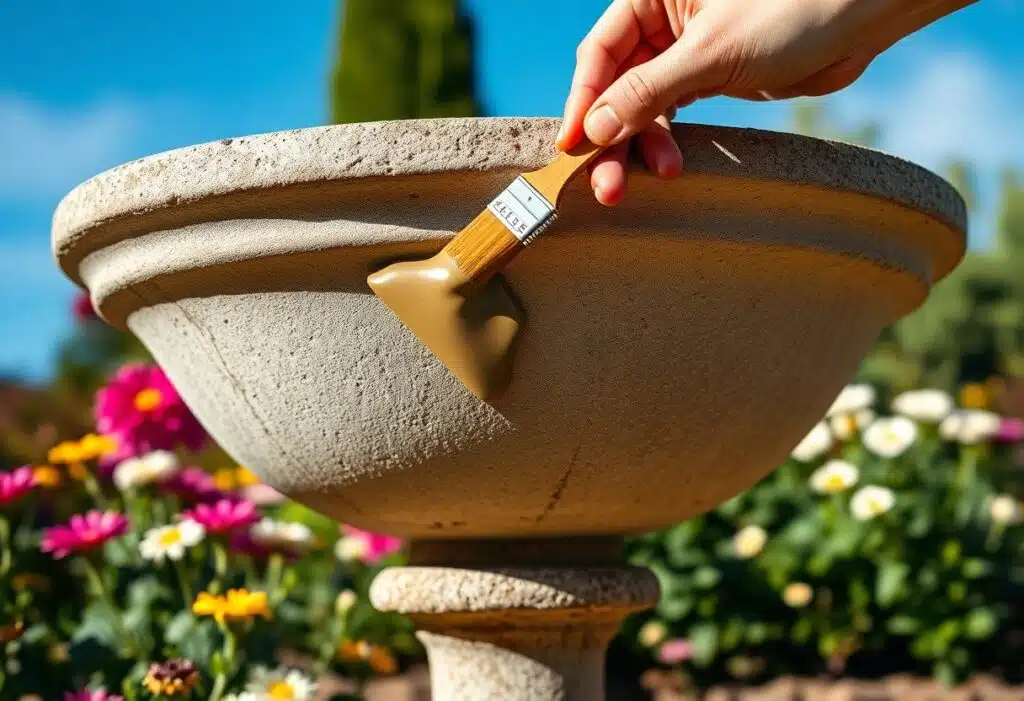How to Seal Concrete Bird Bath?
You want to keep your concrete bird bath in great shape so that your feathered friends can enjoy it all season long. Sealing your birdbath is an important step to prevent leaks and protect it against mold, mildew, and the freeze-thaw cycle. This easy guide will show you how to properly apply a non-toxic sealant. You’ll ensure a durable and smooth surface for your birds, while also making cleanup a breeze. Let’s get started on making your birdbath a safe haven for wildlife!
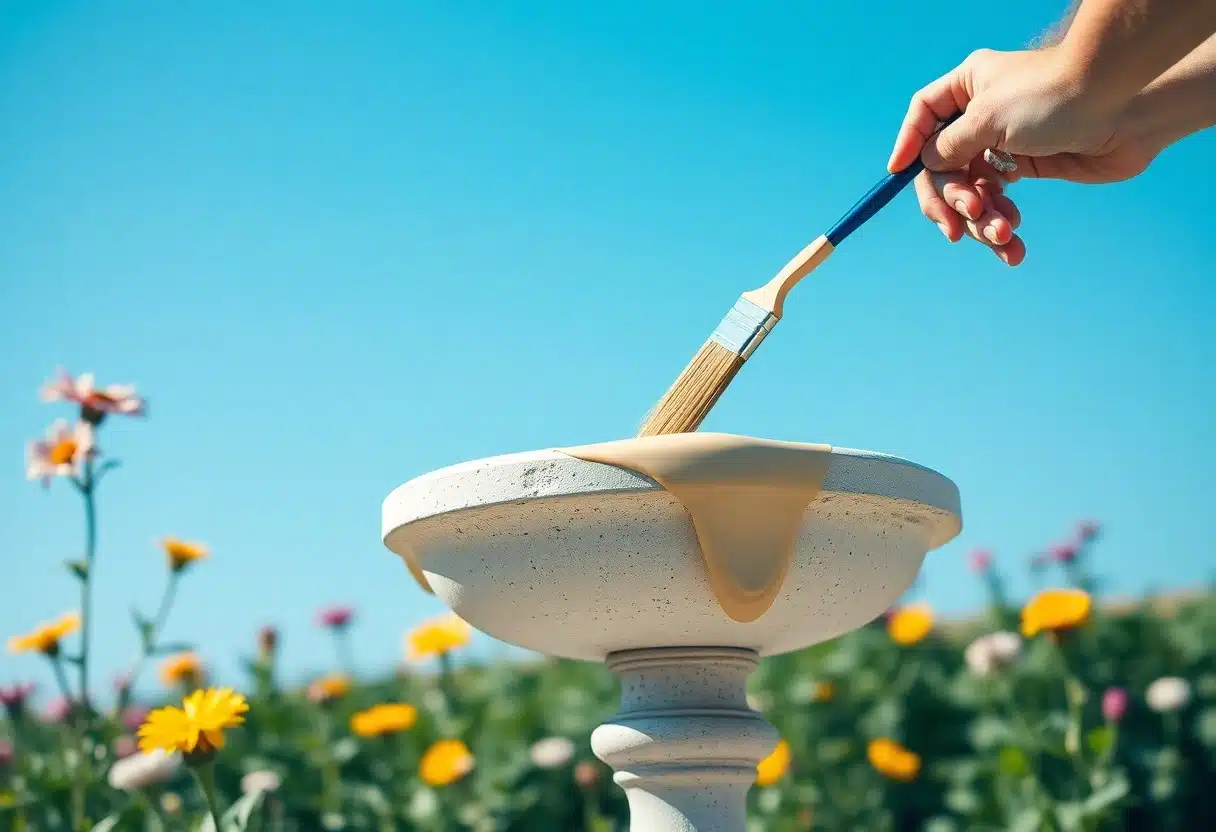
Key Takeaways:
- Choose a Non-Toxic Sealer: When choosing a sealer, it’s important to use a non-toxic product for your concrete birdbath. Look for sealants labeled safe for wildlife to ensure birds can use the bath without harm.
- Clean and Prep Before Sealing: Always clean your concrete birdbath before applying a sealer. Use a scrub brush to remove dirt, mold, and any loose material. Dampen the surface and let it dry completely before sealing.
- Apply Sealant Carefully: Apply a waterproof coat of sealer evenly over the surface of the birdbath. Make sure to reach all areas of the bowl and pay attention to any cracks. Allow the sealer to cure for at least 24 hours to ensure durability.
“Choosing the right sealant will help protect your birdbath from water damage and extend its life.”
Once sealed, your concrete birdbath won’t absorb as much moisture, helping to prevent mold and freezing issues during colder months. Be sure to refresh the water regularly to keep it clean and welcoming for all your feathered friends!
“A well-sealed birdbath will not only look great but also provide a safe space for wildlife to thrive.”
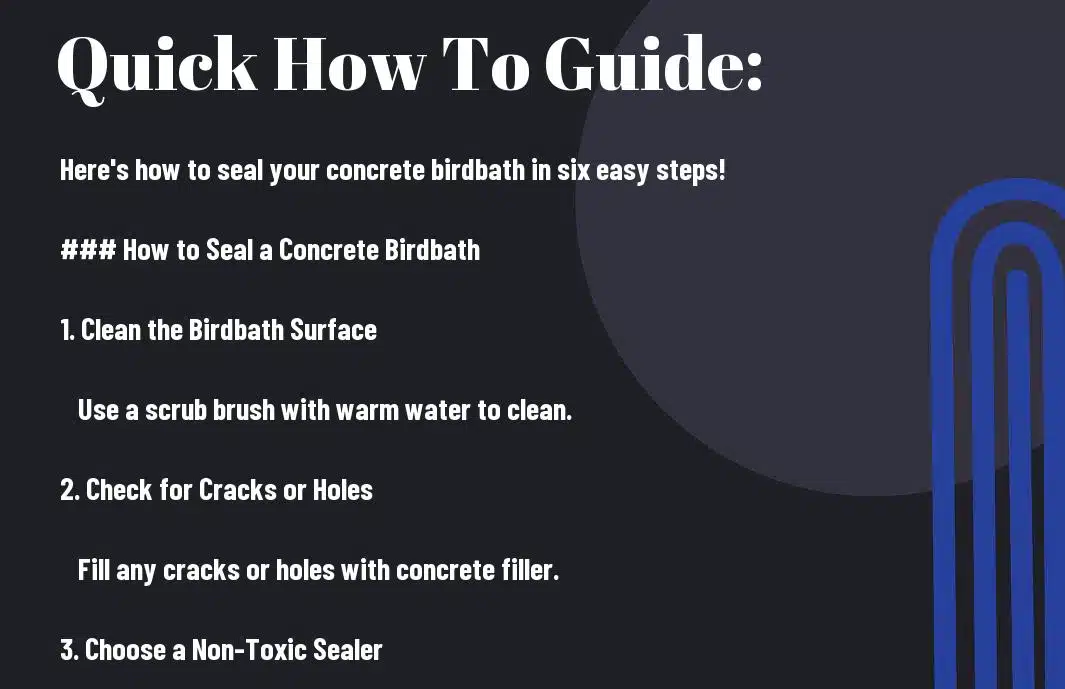
Understanding Concrete Bird Baths
To appreciate the beauty of a concrete bird bath, it’s vital to understand its structure and how it supports wildlife. Concrete bird baths can be both functional and decorative, inviting various birds to enjoy your garden. They come in various shapes and sizes, often crafted to hold water safely while blending into the natural landscape.
Importance of Sealing
The sealing of your bird bath is paramount for maintaining its durability and protecting it from harsh weather conditions. A good sealer helps to prevent cracks and keeps the water in the bowl, ensuring it remains a safe space for birds.
Types of Concrete Used
While there are different types of concrete used in creating bird baths, knowing which one suits your needs is vital. Some popular options include:
- Sand Mix: Absorbs more moisture.
- Portland Cement: Stronger and more durable.
- Epoxy: Provides a waterproof coat.
- Hydraulic: Cures quickly and withstands freeze-thaw cycles.
- CSA Cement: Offers high density and moisture resistance.
Perceiving these differences will help you choose the right material for your bird bath.
| Type of Concrete | Features |
| Sand Mix | Porous and absorbs moisture |
| Portland Cement | Great strength, less susceptible to cracking |
| Epoxy | Waterproof, ideal for sealing |
| Hydraulic | Cures fast, good for outdoor uses |
| CSA Cement | Dense, low moisture absorption |
Sealing your concrete bird bath is vital for its life cycle. If you want to keep water safe for your feathered friends, do not skip this step! Sealing properly will keep your birdbath looking great and help maintain its ability to hold water without leaking. Common sealing products include:
- Concrete Sealers: Protects and waterproofs.
- Paint Sealers: Adds color and protection.
- Epoxy Sealers: Strong and durable.
- Waterproof Coats: Essential for outdoor use.
- Non-Toxic Sealants: Safety for birds is key.
Perceiving the right sealant can make a big difference in your birdbath’s longevity.
“Sealing is vital to protect against freeze-thaw cycles and to keep your birdbath in great shape.”
Lastly, ensure that the sealer you choose is non-toxic and safe for birds. This way, while savoring their splash in your renewed birdbath, you can have peace of mind knowing that their health is protected.
Factors to Consider Before Sealing
Some things to think about before you seal your concrete bird bath include:
- Age and condition of the bird bath
- Types of sealers available
- Specific needs of your local wildlife
- Weather conditions in your area
Knowing these factors will help you choose the right sealer for your concrete birdbath, ensuring it remains durable and safe for birds. For more detailed guidance, visit How to Fix (Resurface) a Concrete Birdbath.
Age and Condition of the Bird Bath
For your bird bath, the age and condition are important. If your bird bath is old or has many cracks, it may need extra repair work before sealing. You should always clean the surface first to ensure the sealer can bond well.
Weather Considerations
Some weather conditions can impact when to seal your bird bath. You want to avoid sealing on hot days because the drying time could be too fast. In contrast, freezing temperatures can cause the sealant to crack. Ideally, you should seal your birdbath when temperatures are mild, allowing the coating to cure properly.
Factors like high humidity or rain can also affect sealing. High humidity can keep the surface damp, making it hard for the sealer to stick. Rain can wash away fresh sealer, so ensure your bird bath is in a protected area or wait for a clear day. Always check the weather forecast before applying a waterproof coat to your bird bath to give it the best chance at lasting without damage.
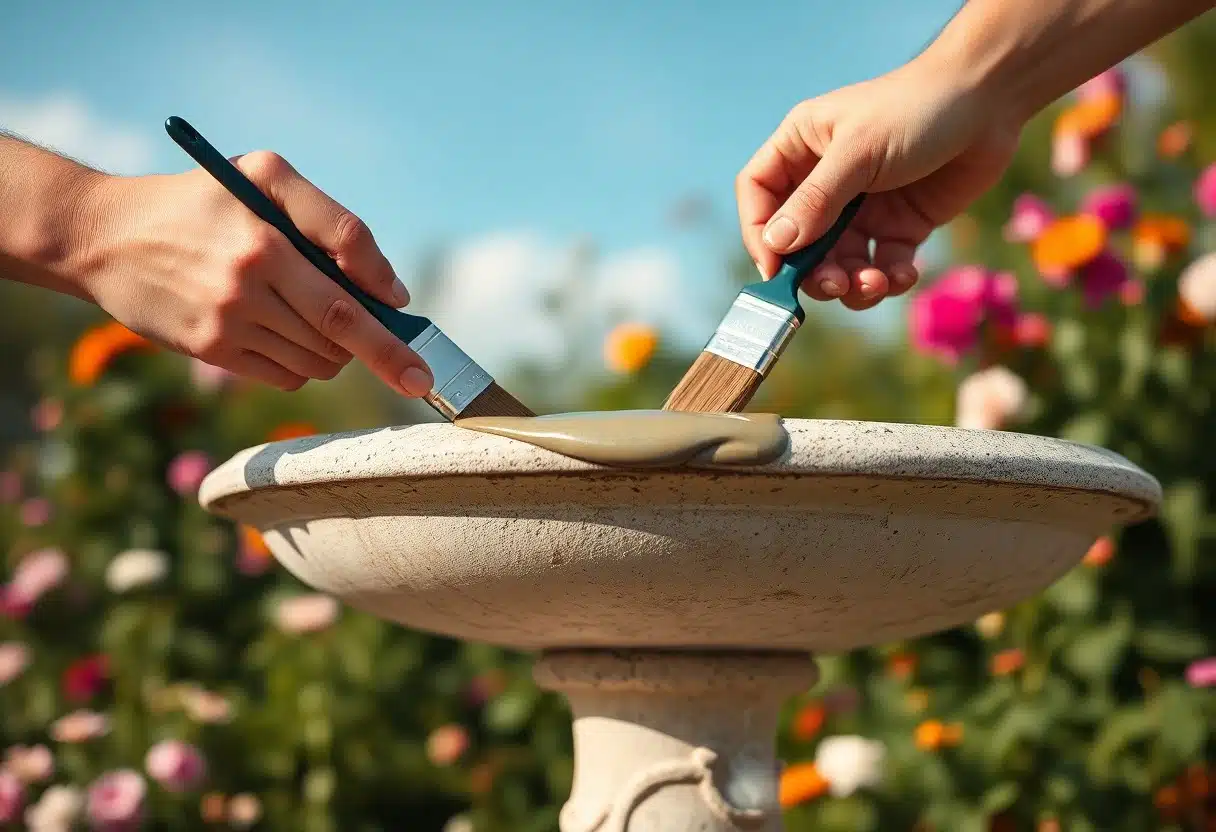
Selecting the Right Sealer
Unlike regular concrete surfaces, your concrete birdbath requires a specific type of sealer to ensure the safety of the birds visiting your yard. It’s important to select a non-toxic product that will effectively protect your birdbath from the elements while still allowing you to maintain the beautiful, inviting space for bird activity.
Types of Sealers Available
- Water-based sealers
- Solvent-based sealers
- Epoxy sealers
- Film-forming sealers
- Penetrating sealers
After reviewing the options, pick a sealer that is easy to apply and durable enough to withstand the freeze-thaw cycle typical in a garden environment.
| Sealer Type | Features |
| Water-based | Quick drying, easy cleanup |
| Solvent-based | More durable; offers deeper penetration |
| Epoxy | Highly resistant to moisture and stains |
| Film-forming | Creates a protective coat on the surface |
| Penetrating | Seals pores without altering surface appearance |
Safety Considerations for Birds
Clearly, when sealing your concrete birdbath, you must prioritize the safety of our feathered friends. Opt for sealants that are specifically labelled as non-toxic, ensuring that the birds can safely use the bath without any health risks.
Another key point is to let everything dry for at least 24 hours before adding water. This is important because even the smallest amount of residual chemicals can harm wildlife. Additionally, steer clear of any products that contain harmful solvents or agents that could degrade the surface or leach into the water. Always check the product labels for assurance and protect your beautiful garden and its visitors.
How to Prepare the Bird Bath for Sealing
Keep your birdbath in prime condition by preparing it properly before sealing. Start with a thorough cleaning to remove all debris, dirt, and old sealer. This step will ensure that your new sealant adheres well to the surface and lasts longer. You’ll enjoy seeing birds come back to a beautifully maintained birdbath!
Cleansing the Surface
Bath your concrete birdbath in a mixture of warm water and a non-toxic soap. Use a stiff scrub brush to get rid of any mold, mildew, or dirt stuck on the smooth surface. This will help to prep your birdbath for sealing. Rinse it thoroughly with fresh water to wash away any remaining soap residue.
Repairing Any Damages
Surface damage should be fixed before sealing your concrete birdbath. If you notice any cracks or holes, use a suitable repair product like epoxy to fill these areas. For instance, apply the epoxy to the damaged spots and let it cure completely. This will prevent water from leaking out and keep your birdbath looking nice. Take care to ensure the repair is smooth and level with the rest of the bowl.
Step-by-Step Sealing Process
All right, let’s get down to sealing your concrete birdbath! This will keep your birdbath looking great and protect it from weather damage. Follow these steps to ensure a proper seal:
| Step | Description |
| 1 | Clean the surface thoroughly with a scrub brush to remove dirt and debris. |
| 2 | Dampen the concrete with warm water; this helps the sealer bond. |
| 3 | Apply a non-toxic concrete sealer using a brush, making sure to cover all areas. |
| 4 | Allow to cure and dry for at least 24 hours before adding water. |
| 5 | Check for leaks or cracks after applying the sealer. |
Necessary Tools and Materials
Any project requires the right tools and materials. For sealing your birdbath, gather the following items:
- Non-toxic concrete sealer
- Scrub brush
- Paint brush or roller
- Warm water
- Mixing container
Application Techniques
Tools are important for applying sealers effectively. When applying your chosen concrete sealer, make sure to work in small sections. You want to ensure even coverage without allowing the sealer to dry too quickly. Use a brush to work the sealer into any pores and create a strong bond. Be cautious of drips, and avoid getting any sealant inside the bowl, as it could affect your birds.
This can be a simple and rewarding process! Ensure that the area is well-ventilated to let any fumes dissipate. Start by applying the sealer in thin, even coats and allow it to fully cure according to the manufacturer’s instructions. The goal is to protect your birdbath from moisture penetration, thus preventing future issues like mold, cracks, and freeze-thaw damage. After about 24 hours, your birdbath should be ready for water, providing a safe haven for your visiting wildlife!
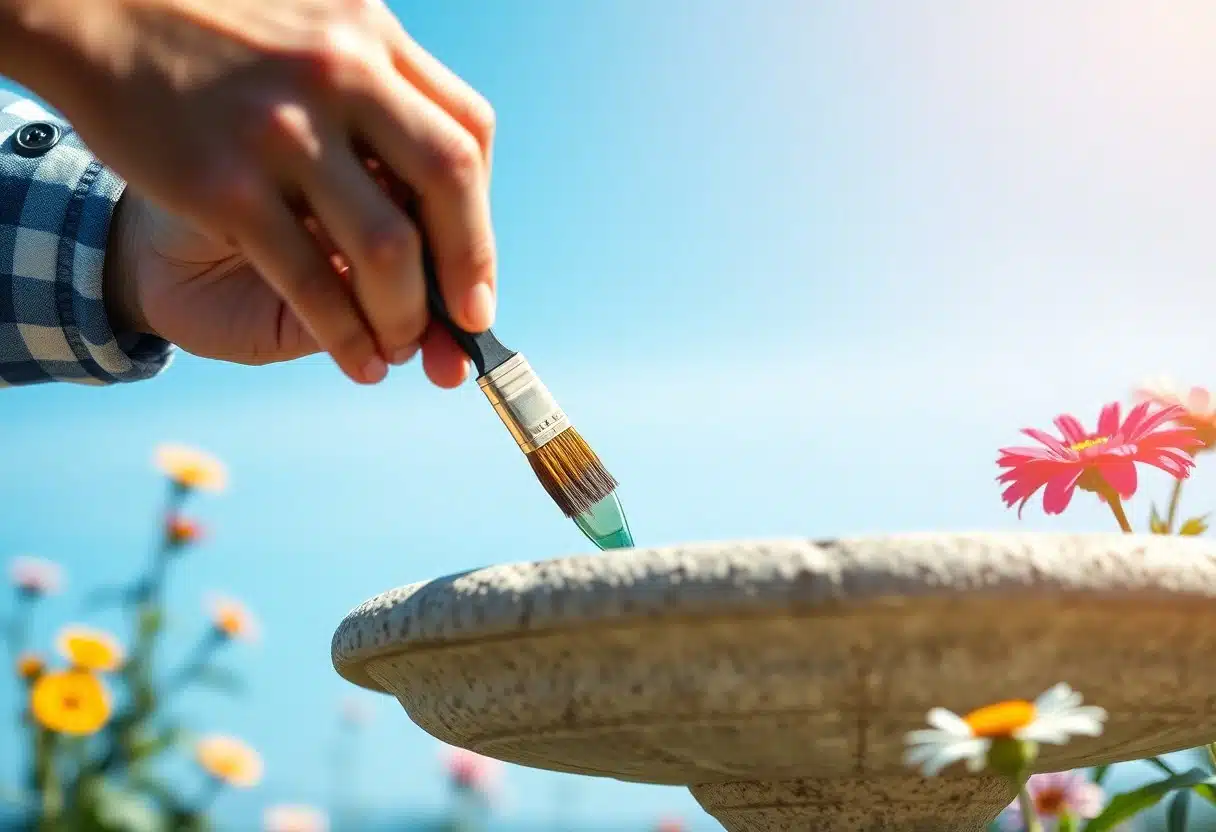
Tips for Maintaining a Sealed Bird Bath
Your concrete bird bath is a beautiful addition to your garden, but it requires some maintenance to keep it in good shape. Here are some tips:
- Use a gentle scrub brush to clean the bowl.
- Refresh the water frequently to prevent algae buildup.
- Check for cracks to repair quickly.
- Keep an eye out for mold and mildew on the surface.
Assume that these simple steps will ensure your birdbath remains a safe and enjoyable spot for your feathered friends.
Routine Cleaning Methods
An effective way to keep your birdbath clean is to scrub it regularly with a non-toxic solution. Mix warm water with a mild soap and use a scrub brush to get rid of dirt, algae, and debris. Rinse it well afterwards to ensure the cleaning solution is completely washed away, keeping your wildlife safe.
Frequency of Resealing
There’s no need to reseal your birdbath often, typically once every 1 to 2 years is sufficient. However, you should inspect your seal regularly for wear and tear to ensure it’s still effective.
With seasons changing, especially during the harsh freeze-thaw cycles, your concrete birdbath may develop cracks. This can let water seep in and lead to problems, especially if you notice signs of water leaks or porous areas. When resealing, always use a non-toxic sealer safe for birds. A good, durable waterproof coat will help protect against damp conditions. In hot weather or freezing temperatures, seal the birdbath after a good cleaning, allowing it to cure for at least 24 hours before refilling with water.
Final Words
On the whole, sealing your concrete birdbath is an important step to protect it from damage and to keep it safe for your feathered friends. You can use a non-toxic concrete sealer to create a waterproof coat that prevents cracks and leaks, helping the bowl hold water without degrading. Be sure to scrub the surface clean before applying the sealant, and allow it to cure for at least 24 hours. If you’re in a hot climate or facing freezing temperatures, adjust your timing and preparations to ensure a strong bond that lasts. This simple fix can greatly enhance the longevity and beauty of your garden’s wildlife space.
FAQ
Q: How do I seal my concrete birdbath?
A: To seal your concrete birdbath, first clean it thoroughly with a scrub brush. Then, apply a non-toxic sealer meant for birdbaths. Make sure to follow the instructions on the sealant for the best results, applying when temperatures are mild.
Q: Why should I seal my old concrete birdbath?
A: Sealing your old concrete birdbath helps to protect it from water absorption, which can cause cracking over time. A good sealer will create a waterproof coat, preventing dirt and moisture from penetrating the surface.
Q: When can I apply a sealer after fixing my birdbath?
A: You should wait at least 24 hours after repairing the birdbath for the cement to cure before applying a sealer. This ensures that the repair is strong and will not be compromised.
When choosing a sealer, look for a non-toxic option that is safe for wildlife. This way, you can protect the birds and make sure your birdbath lasts.
After you prepare your concrete birdbath and repair any cracks, sealing it will give it an extra layer of protection. Here are some helpful tips:
– Clean the surface properly to remove dirt and old paint. – Choose a sealer specifically designed for birdbaths and outdoor use. – Apply the sealer in warm weather to help it bond better.
By sealing your concrete birdbath, you can help it withstand freeze-thaw cycles and prevent water from leaking, making it a safe spot for your feathered friends!
Taking these steps helps your garden stay vibrant and inviting for all types of wildlife, ensuring that your birdbath holds water and remains usable for years to come.
As a bird enthusiast with a passion for sharing the wonders of our feathered friends. As a writer and nature lover, I'm thrilled to connect with fellow bird buffs and inspire others to take flight into the fascinating world of birds. Let's wing it together!

